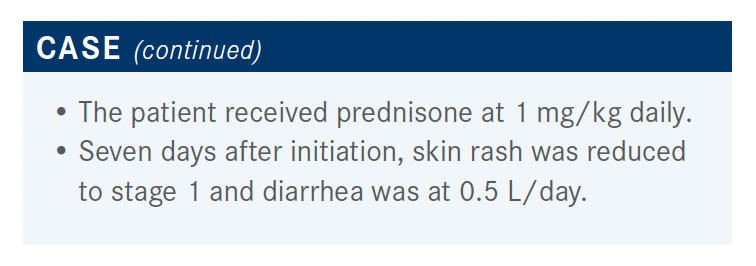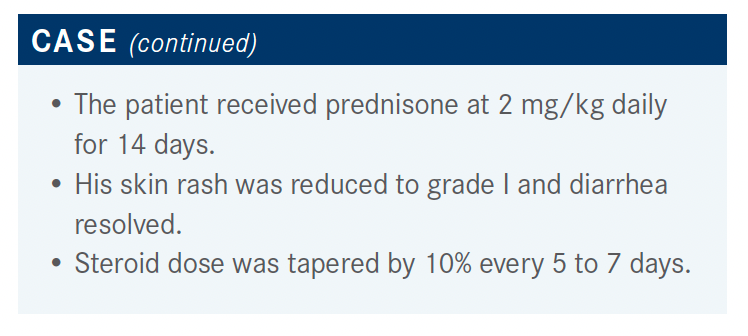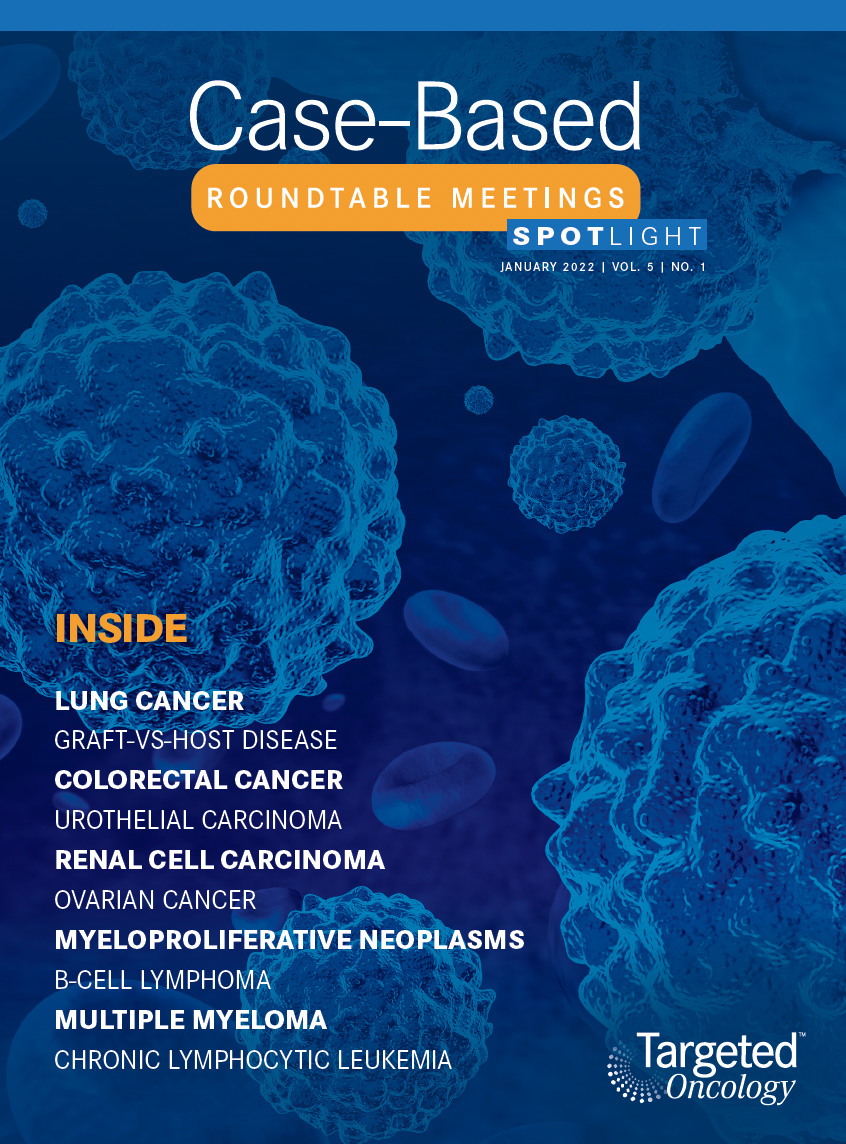Cutler Reviews the Role of Ruxolitinib in Patients With Acute GVHD
Twenty-two days following transplantation, a patient with graft-versus-host disease presented with new symptoms.
Corey S. Cutler, MD, MPH

During a Targeted OncologyTM Case-Based Roundtable event, Corey S. Cutler, MD, MPH, medical director, Adult Stem Cell Transplantation Program Dana-Farber Cancer Institute in Boston, MA, discussed the treatment of a 48-year-old patient with acute graft-versus-host disease (GVHD).

Targeted OncologyTM: Can you discuss staging and grading in acute GVHD (aGVHD), according to the MAGIC Consortium?
CUTLER: Staging refers to individual organs and always uses Arabic numerals: 0, 1, 2, 3, and 4.1 Each individual organ is given a stage. The person in this case, based on the history you’ve been given, has a greater than 50% maculopapular rash, so that’s a stage 3 skin involvement. They had 4 episodes of diarrhea, so that’s a stage 1 gastrointestinal [GI] tract involvement. So just remember those: stage 3 skin, stage 1 gut.
We put all the individual organs’ stages into an overall grade.1 There’s no reason to memorize this, [as] there are several different versions of how this works, but this person has overall grade II GVHD, by virtue of having both a stage 3 rash and a stage 1 GI involvement. For us, grade II to IV in general means [treating with] systemic corticosteroids. I would be confident enough, with this type of presentation, [to] simply jump right in. I would do the biopsies, but I would probably start the steroids while waiting for the biopsy confirmation to come back because you can take away the steroids in 48 hours. [However], if that GVHD progresses dramatically [in 48 hours], then you’ll have wasted an opportunity to treat GVHD at a somewhat earlier stage and grade.
I would probably pull the trigger and [treat systemically] for grade II to IV. With grade I, where you only have isolated skin involvement, you can get away with topical therapy, but it’s hard to get greasy clobetasol onto 60% of the body surface, so that’s just not going to fly for too long.
How do you stratify risk in aGVHD?
CUTLER: Now that we’ve developed what our overall stage and grade is, there are other ways we can prognosticate how this patient is going to do. There are a couple of risk stratification systems. I personally have not found that they’re very useful, but the most widely used clinical one is the Minnesota scoring system.2 It somewhat haphazardly lumps individual organs, stages, and grades together. The bottom line is: The [most] people in this staging system have what they considered standard risk, so 85% are standard risk and 15% are high risk. When the staging system is that unbalanced, it doesn’t give you that much prognostic information, if almost everybody is in the same standard risk. The group at Minnesota, led by Margaret MacMillan, MD, looked at the likelihood of response to corticosteroids and treatment-related mortality.2 The [high-risk and standard-risk] curves split, but there’s certainly room for a little more of a refined prognostic strategy here. That’s what many groups have been working on, particularly the group at Mount Sinai, led by James Ferrara, MD, and John Levine, MD.
You start to see a little more [up-to-date], 2021 prognostic scoring in systems [when you look at stratification] based on biomarkers of disease activity. The biomarkers we use here are not terribly important to remember, except to know they [largely] reflect markers of tissue injury. [Biomarkers used in a 2012 study by Levine et al include] elafin and REG3α, which are released by injured skin and gut, respectively; inflammatory cytokines, like IL-2, tumor necrosis factor, IL-8; and human growth factor, which is a marker of regenerative capacity.3 We have all sorts of different biomarker panels we use now, and these biomarker panels can separate patients into lower- and higher-risk disease.
The current biomarker panel we use the most is a small panel of 3 markers: REG3α, ST1, and 1 of the inflammatory cytokines. If you’re interested in figuring out these panels, you have to send the biomarkers out to Viracor. Because they’re all ELISAs [enzyme-linked immunosorbent assay], many of them are not available at our local hospitals, and the regression algorithm to get a final score is proprietary. No one can calculate a risk score unless you have the regression coefficients.

Can you discuss some of the considerations of usingcorticosteroids as first-line therapy for aGVHD?
CUTLER: As we mentioned, the primary therapy [for] aGVHD is corticosteroids.4 The goals of first-line therapy are disease remission, long-term minimization of organ-related toxicities, and improvement in overall survival.
FAZAL: In a case like this, there are other factors that sometimes make it difficult to understand whether the ongoing diarrhea is related to lack of response or [whether] it is attributed to another etiology. In terms of assessing the response to therapy for steroids and diarrhea assessment, it’s difficult to attribute—especially if there is GI damage—because sometimes they can continue to have some diarrhea for a period of time before they have a noticeable improvement. But the fact that the skin rash got better seems somewhat good.
In terms of the steroid-sparing approach, studies have shown that ruxolitinib [Jakafi] is effective in steroid-refractory GVHD. For somebody who’s had partial response to therapy, you would assume it would also be helpful to use ruxolitinib in that setting, to lower the steroid dose.

CUTLER: Let’s talk about steroid responsiveness and some of the definitions we use. There are definitions we use that specifically relate to steroid responsiveness, resistance, refractoriness, dependence, and intolerance.5 Intolerance is the easiest one to understand. Intolerance means the patient can’t take the steroids because of hyperglycemia, hypertension, severe bone disease, etc. In those cases, you need to find alternative therapy. This case would be steroid resistance: someone who did not get a real improvement after about a week of the drug, or [who] progressed after 3 to 5 days.
aGVHD can be considered refractory or primary refractory in [several cases]. There’s no response to steroids at all. In another 25% of cases, there’s an initial response, but then there’s a disease recrudescence as the steroids are tapered, so it’s very important to give the drugs [for a] long enough [time, as] the main issue is [that] you need to give the GI tract time to heal. Five to 7 days may not necessarily be long enough. For someone who looks well and has only half a liter of diarrhea per day, I probably would not make a move after 7 days of therapy. I would [probably] give that person a full 10 to 14 days before piling on a second- and third-line agent. All you do in those scenarios is expose the patient to greater risk of immune compromise and infection.
PROOTHI: This patient received [prednisone at] at 1 mg/kg and if he had received 2 mg/kg, maybe he would have had a better response.
CUTLER: It’s quite possible. I personally would have started with 2 mg/kg. At a certain point, one gets above, or very far above, a therapeutic index for steroids as an anti-inflammatory. It’s quite possible that, at a certain point, it doesn’t matter whether they get 1, 2, or 5 mg/kg. I’m not sure we know where that inflection point lies. But, for low-grade GI involvement, I would give this person 10 to 14 days before I would declare this a failure, and I would move on at that point.
Can you discuss drugs that are second-line therapy for aGVHD?
CUTLER: [When we look at the NCCN (National Comprehensive Cancer Network) guidelines],6 we get to this humongous laundry list of drugs, many of which have very sketchy data, and almost all of which are used with a folkloric approach at each individual institution. What’s important to know is that, in aGVHD, the only drug that has an FDA label for second-line therapy and above is ruxolitinib. Alpha-1 antitrypsin is being actively tested, antithymocyte globulin [ATG] is the most used agent in Europe, and patients who are not already on calcineurin inhibitors should be on them. There are some centers that use extracorporeal phototherapy, a lot of places will add mycophenolate mofetil [MMF] [CellCept, Myfortic] or sirolimus [Rapamune, Rapamycin], and there are other drugs that are used very rarely. But clinical trials carry the day because we are far from understanding which drugs belong where in an algorithmic approach to aGVHD.
Can you discuss the data behind ruxolitinib as second-line therapy for aGVHD?
CUTLER: Ruxolitinib is the only drug that is approved by the FDA for steroid-refractory aGVHD, and [is] the only drug that has good data. There are 2 trials to know about. The first was called the REACH1 [NCT02953678] trial, and this was an open-label phase 2 trial that was done to evaluate ruxolitinib at a dose of 5 mg twice daily in patients with steroid-refractory aGVHD.7,8 The primary response was measured at day 28. Seventy patients were entered, although the approval of ruxolitinib was based on patients who were steroid-refractory, and in this trial, patients who were steroid-refractory or steroid intolerant were allowed to enter.
In this open-label phase 2 trial with a hand-selected patient population, the overall response rate 1 month after initiating therapy was 55%. The nice thing about ruxolitinib is that if the patients are going to respond, they’re going to respond rather quickly—within a week. The median duration of response was long at a year. The nonrelapse mortality in this patient population remained exceptionally high at 44%, so even patients who responded were seriously at risk of nonrelapse mortality, predominantly related to infectious morbidity.9,10
The randomized phase 3 trial of ruxolitinib was called the REACH2 trial [NCT02913261].8 Individuals with steroid-refractory aGVHD were randomized to receive ruxolitinib or best available therapy [BAT]. BAT was limited to 8 or 9 choices, and you could argue that some of those are not actual BAT today, in the sense that nobody uses etanercept [Enbrel], nobody uses low-dose methotrexate, [and] very few people use mesenchymal stromal cells because they don’t exist as a commercial entity. You can make the argument that the BAT arm was at a disadvantage. The other thing was that the investigators learned how to use ruxolitinib a little better, and their ruxolitinib was dosed at 10 mg twice daily.
The overall responses are presented at day 28 and day 56.11 [Although] the results demonstrated superiority for ruxolitinib at day 28, by improving the response rate by about 50%—comparing the 40% response of the BAT group [with] the 60% response of the ruxolitinib group [odds ratio (OR), 2.64; 95% CI, 1.65-4.22; P < .001]—those responses had dramatically dropped by just 4 weeks later. By day 56, the ruxolitinib treatment group response rate was under 40% [OR, 2.38; 95% CI, 1.43-3.94; P < .001]. So the durability of response left something to be desired, and if you look at which patients responded, it was predominantly the patients who had grade II rather than grade III or IV disease. The likelihood of response was much higher in grade II disease, unfortunately. There was still substantial morbidity and mortality in the BAT arm, with about 90% mortality at 1 year. A fair number of ruxolitinib patients still ended up coming off the drug over time. The skin and the lower GI tract had somewhat different responses to ruxolitinib. In the BAT arm, there were many more responses in the skin than there were in the GI tract, suggesting that skin disease is a little easier to treat. It was very clear that overall failure-free survival was significantly better in the ruxolitinib arm.
What are the potential toxicities or safety concerns with ruxolitinib?
CUTLER: If we look at [adverse] effects, it’s very important to understand that ruxolitinib causes cytopenias. The reason is that this is an on-target, unwanted [adverse] effect. Both erythropoietin and thrombopoietin signal through JAK-coupled receptors, so if you are hitting the JAK receptors effectively, you are eventually going to cause both anemia and thrombocytopenia.
Now anemia takes a lot longer, which is why there was no difference in the rates by day 28, but you can see thrombocytopenia was a fair bit more prominent in the ruxolitinib arm.
In addition, there is an excess amount of CMV infections—and other viral infections, probably, as well—but those are much rarer, and therefore harder to quantify. So for those of you treating patients who are actively being treated with ruxolitinib, monitoring for CMV is always an absolute must.

Please discuss the poll results.
CUTLER: [Ruxolitinib is] not always the right answer in clinical practice, although, for some of our patients who have severe thrombocytopenia going into their aGVHD therapy, you can’t use ruxolitinib because you’ll never get their platelets to come up. It’s in scenarios like that where another therapeutic modality might be indicated. The real answer should be clinical trial because I am not convinced that ruxolitinib, yet, is the end-all and be-all for aGVHD therapy, but it’s the best option we’ve got [at the moment].
Could this patient have CMV prophylaxis while on the ruxolitinib?
CUTLER: The CMV prophylactic agents we have now are limited to 2 drugs. The older way to do this would be with valganciclovir [Valcyte], an orally available version of ganciclovir [Zirgan]. That drug is not tolerated well in the long term, because it, too, causes severe cytopenias, particularly thrombocytopenia. Valganciclovir would never be the right choice. The newer agent we’re using these days for CMV prophylaxis is letermovir [Prevymis].
That drug could be considered in this scenario. It’s never been formally tested. For some of our patients, particularly those who are undergoing haploidentical transplant or cord blood transplant, we use it as primary prophylaxis. Some centers will use letermovir in all unrelated donors for primary prophylaxis.
You could consider using it in a scenario like this. My personal practice pattern is to intensify monitoring because you don’t lose much by waiting for CMV to appear and treating it at that time with valganciclovir. It’s a practice pattern thing. You could make the argument that letermovir is correct in someone who’s going to go on ruxolitinib, but you also could intensify your monitoring strategy.
What is your approach in tapering steroids in steroid-refractory aGVHD?
CUTLER: That’s something I think a lot of us have changed our approach to recently. There are some patients who are steroid refractory, and you’re pounding them with 150 mg of prednisone or methylprednisolone [Solu-Medrol] a day, and it’s not working. So what do you do when you start the ruxolitinib, or whatever your second-line therapy is?
I’ve taken the approach of starting to taper steroids, because at those doses of steroids without response, all you’re doing is adding the potential for toxicity and infection. I try to bring patients down to no more than 1 mg/kg at that point, and as soon as they start responding to second-line therapy, I try to get the steroids off because they clearly weren’t helping. Again, this is a personal practice rather than a written rule, but I think we’re learning that when steroids aren’t working, getting rid of the steroids is probably not a bad thing. I’m too hesitant to go below 1 mg/kg, but some of my colleagues will. What do you do?
FAZAL: [I would make the] same decision. As soon as they respond to second-line therapy, I’m more aggressive in taking off the steroids at that point in time. Until that time, we do worry about the fact that taking off steroids could further worsen our lack of response to the second-line therapy. That’s where it starts to get a little tricky, but as soon as they respond, it’s easier. Until that time, it’s just difficult to determine how much the steroid is harming the patient and [whether] you are increasing the risk of other infections.
When you start ruxolitinib, do you start with a lower dose, like 5 mg twice daily, and escalate the dose, or do you just start with the 10 mg twice daily?
CUTLER: For aGVHD, in the absence of cytopenias, I just go right to 10 mg twice daily. For chronic GVHD [cGVHD], I start on the lower 5 mg twice daily for a couple weeks to make sure their counts will tolerate it. You’re in less of a rush in cGVHD, so there’s some room to build up a dose.
REFERENCES
1. Harris AC, Young R, Devine S, et al. International, multicenter standardization of acute graft-versus-host disease clinical data collection: a report from the Mount Sinai Acute GVHD International Consortium. Biol Blood Marrow Transplant. 2016;22(1):4-10. doi:10.1016/j.bbmt.2015.09.001
2. MacMillan ML, Robin M, Harris AC, et al. A refined risk score for acute graft-versus-host disease that predicts response to initial therapy, survival, and transplant-related mortality. Biol Blood Marrow Transplant. 2015;21(4):761-767. doi:10.1016/j.bbmt.2015.01.001
3. Levine JE, Logan BR, Wu J, et al. Acute graft-versus-host disease biomarkers measured during therapy can predict treatment outcomes: a Blood and Marrow Transplant Clinical Trials Network study. Blood. 2012;119(16):3854-3860. doi:10.1182/blood-2012-01-403063
4. Im A, Hakim FT, Pavletic SZ. Novel targets in the treatment of chronic graft-versus-host disease. Leukemia. 2017;31(3):543-554. doi:10.1038/leu.2016.367
5. Schoemans HM, Lee SJ, Ferrara JL, et al. EBMT-NIH-CIBMTR Task Force position statement on standardized terminology & guidance for graft-versus-host disease assessment. Bone Marrow Transplant. 2018;53(11):1401-1415. doi:10.1038/s41409-018-0204-7
6. NCCN. Clinical Practice Guidelines in Oncology. Hematopoietic cell transplantation, version 2.2021. Accessed April 23, 2021. https://bit.ly/3ocIjNV
7. Chao N. Finally, a successful randomized trial for GVHD. N Engl J Med. 2020;382(19):1853-1854. doi:10.1056/NEJMe2003331
8. Jagasia M, Zeiser R, Arbushites M, Delaite P, Gadbaw B, Bubnoff NV. Ruxolitinib for the treatment of patients with steroid-refractory GVHD: an introduction to the REACH trials. Immunotherapy. 2018;10(5):391-402. doi:10.2217/imt-2017-0156
9. Jagasia M, Perales MA, Schroeder MA, et al. Ruxolitinib for the treatment of steroid-refractory acute GVHD (REACH1): a multicenter, open-label phase 2 trial. Blood. 2020;135(20):1739-1749. doi:10.1182/blood.2020004823
10. Jagasia M, Salhotra A, Bachier CR, et al. KD025-208: a phase 2a study of KD025 for patients with chronic graft versus host disease (cGVHD) - pharmacodynamics (PD) and updated results. Biol Blood Marrow Transplant. 2019;25(suppl 3):S28-S29. doi:10.1016/j.bbmt.2018.12.100
11. Zeiser R, von Bubnoff N, Butler J, et al. Ruxolitinib for glucocorticoid-refractory acute graft-versus-host disease. N Engl J Med. 2020;382(19):1800-1810. doi:10.1056/NEJMoa1917635
